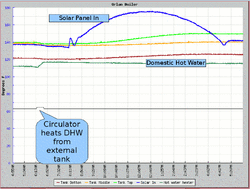Grover59
Member
sled_mack said:Maine said:solarguy said:Also, a low temperature radiant heat system is the balls for a solar application, I'm talking about temperatures in the 85, 90 to 100 degree range. The problem is most of those radiant systems are expensive to install when compared to typical "staple up system" that operate at 140 to 160 degrees.
I plan on installing staple up radiant heat, and the reason is so that I can get to lower temps with my storage tank, I was under the impression that staple up with the aluminum plates would work with lower temps, so long as you insulate and use the shiny deflector stuff.
Steve
I did my first radiant floors over 10 years ago. Staple up with no plates and foil insulation. A few years ago I did staple up with thin plates.
Thin plates work better than no plates. Since half my house already had staple up with no plates (and I didn't want to replace it) using thin plates on the later areas kept the heat transfer rates close to the same.
If you want to use staple up and low temps, you need to use thick plates. These are generally extruded aluminum. There are a few staple guns that will put them up with the right staple. Or, you can drill them and use short screws to hold them up.
Everything I've read says that the reflective insulation is a bit of a joke. Once it gets dusty, it's ability to reflect goes way, way down.
There is a lot of variance in staple up applications. If you want to use low water temps you have to plan ahead for it - thick plates and good insulation are a must.
Ok what I was going to do is make my own plates with aluminum flashing, these things tend to be expensive already made what do you recommend?
Steve


